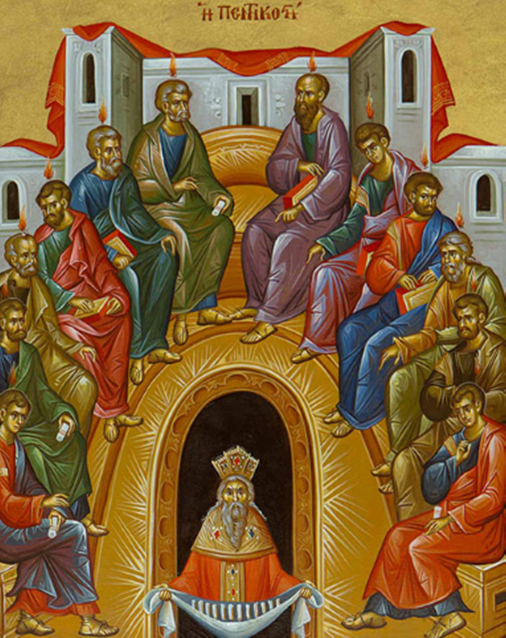Pentecost

In the Old Testament, Pentecost was the feast which occurred fifty days after Passover (Pentecost celebrated God’s gift of the Ten Commandments to Moses on Mount Sinai). In Christian Tradition, fifty days after the Resurrection and ten days after Christ’s Ascension, we celebrate the Feast of Pentecost (Acts 2:1-4). The fiftieth day stands as the beginning of the era which is beyond the limitations of this world, fifty being that number which stands for eternal and heavenly fulfillment in Jewish and Christian mystical piety: seven times seven, plus one. Jesus sends the Holy Spirit down as His Advocate, Comforter, and Guide to enable the Apostles to continue their mission and evangelization of the world. The apostles received “the power from on high,” and they began to preach and bear witness to Jesus as the risen Christ, the King and the Lord. PENTECOST SUNDAY is seen as the culmination of the revelation of the Holy Trinity, thus it is also called “Trinity Sunday.” The One God is the Father, and the Son, and the Holy Spirit. One God worshipped in three Persons. We believe in, worship and adore the “holy, consubstantial, life-creating, and undivided Trinity.” We celebrate the Feast of Pentecost with the Liturgy of Saint John Chrysostom. For the first time since Pascha, we sing the hymns "O Heavenly King ... " and "We have seen the True Light" calling the Holy Spirit to "come and abide in us," and proclaiming that "we have received the heavenly Spirit." An extraordinary service called the Kneeling Service is done immediately after the Liturgy. Everyone makes a full prostration, touching their foreheads to the floor (prostrations in church having been forbidden from the day of Pascha up to this point). We, by our own membership in the Church, have received “the seal of the gift of the Holy Spirit” in the sacrament of Chrismation. PENTECOST has happened to us.
La Pentecôte
La Pentecôte (GR pentêkostê cinquantième jour) désigne les 50 jours qui suivent la Résurrection (Actes 2 : 1-4). Chez les Hébreux, la Fête de Pâque commémorait leur délivrance de la servitude en Égypte et la traversée de la Mer rouge. Cinquante jours plus tard, sur le Mont Sinaï, Moïse reçoit de Dieu les Tables de la Loi. C’est en ce jour anniversaire que les apôtres reçoivent l’Esprit-Saint. Jésus envoie le Saint-Esprit en tant que consolateur et guide pour permettre aux apôtres de poursuivre leur mission et leur évangélisation du monde. Ils reçoivent « le pouvoir d’en haut » et commencent à prêcher et à rendre témoignage à Jésus en tant que Christ ressuscité, Roi et Seigneur. Le Dimanche de la Pentecôte est considéré comme le point culminant de la révélation de la Sainte Trinité. Il est également appelé « Dimanche de la Trinité » : le Dieu unique est le Père, le Fils et le Saint-Esprit. Un dieu adoré en trois personnes. Nous croyons, glorifions et adorons la « Trinité sainte, consubstantielle, créatrice de vie et non divisée ». Pour la première fois depuis Pâques, pendant la Sainte Liturgie, nous récitons « Roi céleste ... » et chantons « Nous avons vu la Vraie Lumière », appelant le Saint-Esprit à « venir et demeurer en nous », et proclamant que « nous avons reçu l’Esprit céleste (...). Adorons l’indivisible Trinité, car c’est Elle qui nous a sauvés. » Aussitôt après la liturgie, commence l’office de l’agenouillement (l’agenouillement n’est pas permis entre Pâques et Pentecôte) : la congrégation chante alors d’une manière solennelle : « Roi céleste, Consolateur, Esprit de vérité, toi qui es partout présent et qui remplis… ». Afin de marquer que, à la Pentecôte, le cycle liturgique atteint sa plénitude, l’Église orthodoxe appelle tous les dimanches qui suivent « dimanches après la Pentecôte ». Elle continue même de les désigner ainsi jusqu’au premier dimanche de la préparation au Grand Carême.